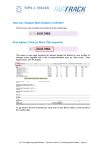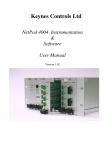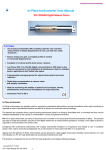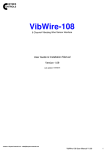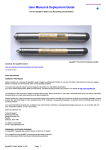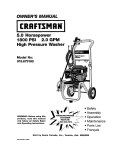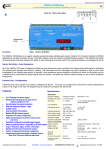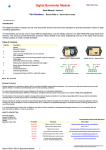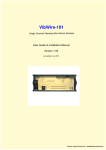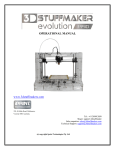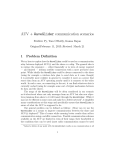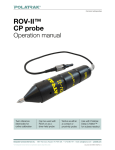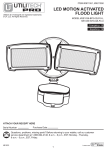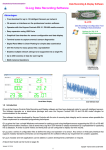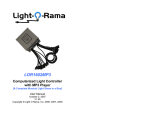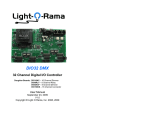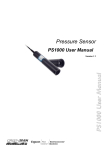Download Installation Guide - Keynes Controls Ltd
Transcript
Geotechnical Instrumentation In-Place-Inclinometer Installation Manual SDI-12/RS485 Digital Network Device Vertical I-P-I Chain Operations Only Last updated Nov 2013 Keynes Controls In-place-inclinometer Installation Guide 1 Table of contents Page No 3 Introduction Warranty Provisions Successful Measurements 4 Pre-installation Communications Test Free Applications Software Media Converters Part Numbers 5 Mechanical Assembly Operations for the Vertical I-P-I Chain Spacer Bars Attaching the In-Place-Inclinometer wheel assembly onto a spacer bar 6 Fastening the spacer bar to the top of the In-place-inclinometer Minor adjustments to the spacer bar alignment and length Rod End Baring 7 Digital Network Connection Network Types SDI-12 RS-485 Securing the digital network signal cable Network Connection Operations 8 Axis alignment Top Mounting Cap Sensor Connection 9 Securing the In-place-inclinometer chain to the casing tube 10 Sensor Connection Pin-outs - glass seals Lumberg Connector Pin-outs - Extension cable Standard signal cable colour codes Advice for successful measurement operations Advice for selecting the sensor chain location Power Supply Rating 11 Interpreting the results 12 Single Sensors or Interfaces Connection Multiple Sensors or Interface Connection Typical Q-Log Panel Meter Screen 13 Cable Routing 14 Physical Dimensions 15 Dimensions for 3 m I-P-I string 16 Long Term In-place-inclinometer chain monitoring systems for n-accessible underground locations. 17 Sensor Installation into a flooded I-P-I Casing 18 Long Term Deployment - damp environment - additional waterproofing Table of Figures Page NO Description 3 Fig 1 - KEYNES CONTROLS In-place-inclinometer 4 Fig 2 - Basic I-P-I test system setup 5 Fig 3 - I-P-I Spacer Bar with plug 5 Fig 4 - I-P-I Spacer bar top piece mount position 5 Fig 5 - I-P-I Wheel assembly mounted on a sensor 5 Fig 6 - I-P-I Wheel assembly mounted on a sensor 5 Fig 7 - I-P-I wheel assembly 6 Fig 8 - Complete I-P-I sensor assembly 6 Fig 9 - Securing the spacer bar to the top of the sensor 6 Fig 10 - Spacer bar locking nut 7 Fig 11 - I-P-I Chain Assembly with network connection 7 Fig 12 7 Fig 13 - Un-sealed network connector I-P-I Sensor with network connectors 7 Fig 14 - Sealed network connector making a waterproof connection 7 Fig 15 - Connection of the I-P-I to a data logger 8 Fig 16 - I-P-I chain showing a common sensor orientation for all sensors. 8 Fig 17 I-P-I Casing 8 Fig 18 - Sensor orientation 8 Fig 19 - I-P-I casing showing the different sensor orientation options 9 Fig 19 - I-P-I casing showing the different sensor orientation options 9 Fig 20 - Top cap securing bolt 9 Fig 21 - I-P-I Wheel assembly alignment to the casing 9 Fig 22 - Measurement Points 10 Fig 23 - Top mounting cap with securing bolt attached 10 Fig 24 - Sensor Connections 10 Fig 25 Lumberg Connector Pin-outs - Female 10 Fig 26 Lumberg Connector Pin-outs - Male 11 Fig 27 - Understanding Axis for I-P-I chain deployment 11 Fig 28 - Understanding Axis for Ceiling / Horizontal Support 12 Fig 29 - In-place-Inclinometer connection to an RS-485 Digital Network 12 Fig 30 - USB-RS485-Pro media converter installed on a laptop computer. 12 Fig 31 - USB-RS485-Pro connection to a single I-P-I RS485 model sensor 12 Fig 32 - In-place-inclinometer test system using USB-RS485-Pro media converter and Q-Log applications software 13 Fig 33 - Cable Routing Guide & Safety bar installation 14 Fig 33 - Rod end baring spacing 14 Fig 34 - Standard I-P-I sensor dimensions 15 Fig 35 - Dimensions for a 3 m I-P-I string 16 Fig 36 - PC Data Acquisition system using isolated RS-485 I-P-I Chain 17 Fig 37 - Water filled I-P-I chain with individually wired sensors to the surface. 18 Fig 38 Dow Coning DC4 Silcone Grease, 18 Fig 39 I-P-I Connector on submerged water test 18 Fig 40 - Mated Lumberg I-P-I Connector 18 Fig 41 - Injecting silicon grease In-Place-Inclinometer User Manual Keynes Controls In-place-inclinometer Installation Guide The user manual can be downloaded at http://www.aquabat.net/downloads/UserManual-IPIv4.pdf 2 1.0 Introduction The following manual details the instruction to follow to assemble the Keynes Controls In-place-inclinometers to form a vertical measurement chain. This manual is meant as a guide only and some prior knowledge on the use of In-place-inclinometers is expected. Where possible Keynes Controls have endeavoured to make sure the parts only fit together in a single way in order to avoid in confusion in any measurement operation. All of the inclinometers described in this manual use a digital network for data communications. All of the sensors are intelligent and undertake any measurement operation internally within the device, Full User manual for the programming of this device is available for free download from the Keynes Controls Web site and can be found at http://www.aquabat.net. 1.1 Recommended Calibration Period For best results Keynes Controls recommends that the sensors are re-calibrated on an annual basis. 1.2 Mounting Bolts All metal parts making up the In-place-inclinometer are constructed from stainless steel. The mounting bolts are M6 and also of stainless steel. 1.3 Successful Measurements For a successful measurement system to be created the in-place-inclinometers should not be subject to mechanical shock during installation. They shall be located away from any sources of local vibration and use the correctly rated power supply. Sensor Top Fit wheel assembly here Secure spacer bar here Fig 1 - KEYNES CONTROLS In-place-inclinometer Sensor Bottom 2.0 WARRANTY PROVISIONS Keynes Controls Ltd . warrants the I-P-I range of tilt sensors for one year from date of purchase by the end user against defects in materials and workmanship under normal operating conditions. To exercise this warranty contact Technical Support at the phone or e-mail address listed below for a return material authorization (RMA) and instructions. Complete warranty provisions are posted on our website at http://www.aquabat.net The information in this document is subject to change without notice. Keynes Controls Ltd. has made a reasonable effort to be sure that the information contained herein is current and accurate as of the date of publication. Keynes Controls Ltd. makes no warranty of any kind with regard to this material, including, but not limited to, its fitness for a particular application. Keynes Controls Ltd will not be liable for errors contained herein or for incidental or consequential damages in connection with the furnishing, performance, or use of this material. In no event shall Keynes Controls Ltd . be liable for any claim for direct, incidental, or consequential damages arising out of, or in connection with, the sale, manufacture, delivery, or use of any product. HOW TO CONTACT US Important Note Technical Support Keynes Controls Ltd Riseley Business Park Riseley Berkshire, RG7 1NW This product contains sensitive electronics and can be damaged by physical shock. Under no circumstances allow the In-place-Inclinometer to be dropped. Tel: (0044) 118 327 6067 E-mail: [email protected] 2.1 FIRMWARE & SOFTWARE UPGRADES The In-place-inclinometer is firmware up-grade able. Contact Keynes Controls Ltd. for details. If you suspect that your In-place-inclinometer is malfunctioning or requires re-calibration and repair is required then contact us. you can help assure efficient servicing by following these guidelines: Keynes Controls In-place-inclinometer Installation Guide 3 3.0 Pre-installation Communications Test On receipt of the I-P-I sensors Keynes Controls recommends that the individual sensors are tested for communications prior to installation. To simplify the testing Keynes Controls offer free applications software to display test data, and a series of media converters to enable the inclinometers to be attached and operated from a Microsoft Windows Operating System PC. 3.1 Free Applications Software The free applications software is called Q-Log. It can be downloaded from http://www.aquabat.net/QLOGFree/qlogv2.html The Q-Log software enables the data to be observed directly in engineering units and to calibrate sensors. 3.2 Media Converters The USB-Pro version sensors offer sensor excitation and automatically loading software drivers to make operation as simple as possible. Simply install the media converter for the desired sensor type into a USB port on a PC. Connect the In-place-inclinometer to the interface using the pin-out shown on the media converter and read the tilt data back into the applications software in a Windows friendly operating environment, No programming experience is required to configure a Keynes In-place-inclinometer. Additional information for the USB media converters can be found at Q-Log applications software running on a Microsoft Windows PC Model: USB-SDI12-Pro http://www.aquabat.net/USBSDpro/USBSDI12proConV1.html Model: USB-RS485-Pro http://www.aquabat.net/downloads/Installation-USB485-Pro-V1.pdf Part No: USB-SDI12-Pro Isolated media converter PC Data Recorder 4.0 Part Numbers Part Number Description IPI-bar-1m 1m gauge bar for any IPI sensor IPI-bar-2m 2m gauge bar for any IPI model IPI-bar-3m 3m gauge bar for any IPI model IPI-case-cap Cap for I-P-I housing SDI-12 network IPI-D-15-SDI12 Dual Axis I-P-I Solid state - +/- 15 deg - SDI-12 Comms - sealed to 100 m IPI-D-75-SDI12 Dual Axis I-P-I Solid state - +/- 7.5 deg - SDI-12 Comms - sealed to 100 m IPI-D-25-SDI12 Dual Axis I-P-I Solid state - +/- 2.5 deg - SDI-12 Comms - sealed to 100 m IPI-S-15-SDI12 Single Axis I-P-I Solid state - +/- 15 deg - SDI-12 Comms - sealed 100 m IPI-S-75-SDI12 Single Axis I-P-I Solid state - +/- 7.5 deg - SDI-12 Comms - sealed 100 m IPI-S-25-SDI12 Single Axis I-P-I Solid state - +/- 2.5 deg - SDI-12 Comms - sealed 100 m RS-485 network IPI-D-15-485 Dual Axis I-P-I Solid state - +/- 15 deg - RS-485 Comms - sealed 100 m IPI-D-75-485 Dual Axis I-P-I Solid state - +/- 7.5 deg - RS-485 Comms - sealed 100 m IPI-D-25-485 Dual Axis I-P-I Solid state - +/- 2.5 deg - RS-485 Comms - sealed 100 m IPI-S-15-485 Single Axis I-P-I Solid state - +/- 15 deg - RS-485 Comms - sealed 100 m IPI-S-75-485 Single Axis I-P-I Solid state - +/- 7.5 deg - RS-485 Comms - sealed 100 m IPI-S-25-485 Single Axis I-P-I Solid state - +/- 2.5 deg - RS-485 Comms - sealed 100 m Keynes Controls In-place-inclinometer Installation Guide 4 Fig 2 - Basic I-P-I test system setup 5.0 Mechanical Assembly Operations for the Vertical I-P-I Chain The creation of an In-place-inclinometer chain is a simple operation. Connect the sensor spacer bars to the I-P-I to make a measurement chain of the desired length. The sensor length is assigned by the overall inclinometer length with a spacer bar to give the desired spacing between the measurement points. The standard measurement points are spaced 0.5, 1, 2 or 3 metres apart. Other distances can be created on request. 5.1 Spacer Bars The sensor bars are supplied with all mounting bolts and with a factory pre-set rod end baring attached. Apart from bolting the spacer bar to the In-place-inclinometer, no other mechanical assembly will be required. Plug securing bolt M6 x 25 mm Locking nut Bar Plug Sensor Top Piece Rod end baring Spacer bar securing point Fig 4 - I-P-I Spacer bar top piece mount position Fig 3 - I-P-I Spacer Bar with plug M6 x 25 mm securing bolt I-P-I wheel assembly mounting bolts M6 x 18 mm Stainless steal Figure 6 opposite shows how the wheel assembly is secured onto the In-placeinclinometer. The wheel assembly is attached to the I-P-I sensor prior to the inclinometer being attached to the I-P-I chain. 5.2 Attaching the In-Place-Inclinometer wheel assembly onto a spacer bar Fig 6 - I-P-I Wheel assembly mounted on a sensor Fig 5 opposite shows how the I-P-I wheel assembly connects to the spacer bar. Line up the rod end baring to the wheel assembly as shown. Slide the red end baring into the wheel assembly Secure the wheel assembly to rod end baring using the supplied M6 x 25 mm stainless steel bolt. Fig 7 I-P-I Completed wheel assembly Fig 5 - Fastening the spacer rod to the wheel assembly Figure 7 opposite shows the baring end rod secured to the wheel assembly. The process is repeated for each In-place-inclinometer on the string. Keynes Controls In-place-inclinometer Installation Guide 5 Fig 8 shows how the In-place-inclinometer should look with the wheel assembly attached. The wheel assembly fits on to all models of the I-P-I sensor in exactly the same manner. Fig 8 - Complete I-P-I sensor assembly 5.3 Fastening the spacer bar to the top of the In-place-inclinometer The spacer bar only fits onto the I-P-I sensor top in one position and aligns the bar to the next adjacent sensor. Slide the spacer bar onto the sensor top mounting piece and secure into place with the M6 x FF mm stainless steal bolt. Make sure the securing nut is tightly fastened. All the spacer bars are secured into place regardless of length in exactly the same manor. Fig 9 - Securing the spacer bar to the top of the sensor Spacer bar 5.4 Minor adjustments to the spacer bar alignment and length. The spacer bars are supplied with a factor aligned rod end baring. Once the spacer bar is attached to the sensor it will correctly align the axis of measurement. In some cases it may be desirable to minor adjustments in the alignment if the bar to correct for any local mechanical irregularities in the sensor casing tubes. 5.5 Rod End Baring The rock end baring is screwed into the bar plug and secured into place with a locking nut. 1. Slacken the locking nut (See Fig 10) 2. Adjust the rod end baring orientation and length to the new desired position. 3. Secure the rod end baring into place by tightening the locking nut. Locking nut Fig 10 - Spacer bar locking nut Keynes Controls In-place-inclinometer Installation Guide 6 6.0 Digital Network Connection The In-place-inclinometer when used on an I-P-I chain is supplied with two network connectors attached at each end of the sensor. In order for the sensors to operate they are daisy chained together to form a digital network. Each sensor connects to the adjacent device along the network once the connectors are secured. The Keynes Controls I-P-I sensors use screw locking IP-68 rated plug and sockets to connect the sensors together. The watertight seal is only formed once the connectors are screwed together. Care has to be taken to make sure the connectors are screwed together tightly prior to deployment on the chain in order to stop the ingress of water to the signal cable cores. I-P-I Chain Top Support I-P-I digital network connectors Fig 12 I-P-I Sensor with network connectors Digital Network Connection 6.1 Network Types The Keynes Controls I-P-I sensors support SDI-12 or RS-485 digital network communications. SDI-12 Network Length Any In-place-inclinometer chain deployed using the I-P-I sensors must not exceed a maximum length of 100 m from the bottom of the I-P-I chain to the data logger. Fig 13 - Un-sealed network connector RS-485 Network Length Any In-place-inclinometer chain deployed using the RS-485 network option I-P-I sensors must not exceed a maximum length of 1000 m from the bottom of the I-P-I chain to the data logger or PC. Fig 14 - Sealed network connector making a waterproof connection 6.2 Securing the digital network signal cable A digital network connects the In-place-inclinometers together on the sensor string and onto the data logger of personal computer system. The network connectors for adjacent pairs of sensors form a matching male / female pair. Fig 14 shows the network connectors secured together to form a watertight seal. As each sensor is attached to the I-P-I string connect the network connectors are to be secured in turn. Fig 11 I-P-I Chain Assembly 6.3 Network Connection Operations SDI-12 network All of the I-P-I sensors to be deployed on a network chain are supplied with 2 x network connectors as shown in Figure 12. I-P-I chain Network Length (m) AquaLOG - Data Logger 1. Secure each sensor to the I-P-I chain as shown in Fig 11. Fig 15 opposite shoes how the network length is determined. 2. Fasten the network connector from the first sensor on the chain to the next one in-line taking care to tighten the screw lock on the connectors to create the watertight seal. See Fig 14 3. The network connectors are factory wired and simply plug together from one sensor to the next. The male plug at one end of the sensor connects to the female socket on the adjacent device. 4. Once the network chain is assembled test the communications to the sensors. It is easier to test the communications for installation into a casing and make corrections as necessary. Fig 15 - Connection of the I-P-I to a datalogger Keynes Controls In-place-inclinometer Installation Guide 7 7.0 Axis alignment In order to undertake a successful measurements all of the in-place-inclinometers have to be aligned in the same axis. The image below demonstrates how the sensors are deployed to ensure the measurement axis are all in the correct orientation. All of the sensors have to aligned on the same axis for the results to be correct. To be secured to a fixed point Important Note - All sensors have to be deployed in the same axis in order for the measurements be be correctly understood. Figure 18 shows the label attached to the sensor that shows the orientation of the critical axis. Sensor Orientation Label Fig 18 - Sensor orientation -Y +X -X +Y Measurement Axis 7.1 Axis of movement Spacer Bars Fig 17 I-P-I Casing Rectangular Casing The orientation of the X-Y axis of movement for the sensor is purely defined by the way the device is fitted into the casing. Fig 19 shows the label fitted to the sensor case and shows the orientation of the axis inside the sensor. When reading data from the sensor it is the orientation shown on the label that defines axis operation. Important Note: Take care to record the orientation of the sensors once they are mounted inside the casing. This information will be required to understand the movement of the sensors. Y-axis X-axis Digital network Y-axis X-axis Fig 16 - I-P-I chain showing a common sensor orientation for all sensors. Fig 19 - I-P-I casing showing the different sensor orientation options Keynes Controls In-place-inclinometer Installation Guide 8 7.1 Securing the In-place-inclinometer chain to the casing tube Figure 20 - Top cap securing bolt The I-P-I chain is secured to the casing using the Top Mounting Cap as shown in figure 20. The I-P-I chain is suspended into place once the cap is placed on top of the casing. The weight of the I-P-I chain helps to secure the sensor into place, 1. Slide the mounting cap over the spacer bar until it is passed the the hole for the securing bolts. Securing Bolt 2. Fix into place the securing bolt and tighten. The securing bolts are M6 x 25 mm. 3. Lower the top mounting cap into place on to of the casing tube. I-P-I casing Survey Point Fixed Datum Position ID=0 -Y Measurement Point +X -X Casing tube showing wheel groves for sensor alignment +Y Fig 21 I-P-I Wheel assembly alignment to the casing ID=1 -Y Measurement Point +X -X +Y 7.2 Lowering the I-P-I chain into the casing ID=2 Once the I-P-I chain is assembled and tested it can be lowed into the I-P-I casing. -Y Measurement Point +X -X +Y Make sure all the sensors are aligned in the same way prior to installing into the tube. Line up the wheel assembly with the groves in the casing. and slowly lower the sensor chain into the casing. Bottom Cap Fig 22 - Measurement Points Keynes Controls In-place-inclinometer Installation Guide 9 Take care when fitting the sensors into the casing that the chain is not dropped. Should the sensor I-P-I chain be dropped to the bottom of the casing then damage due to mechanical shock. The Top Mounting Cap secures the I-P-I spacer bar for the top sensor to the top of the I-P-I casing. Top Mounting Cap Figure 23 opposite shows the spacer bar attached to the top cap and secured into place by an M6 x 25 mm stainless steel bolt. Connections to glass seal - internal to the sensor RS-485 Sensor SDI-12 Sensor Earth 6 1 Gnd / 0V N/A 5 2 +12V DC 4 3 N/A Earth 6 1 Gnd \ 0V N/A 5 2 4 3 RS-485 - RS-485 + +12V Fig 23 8.0 Sensor Connection Figure 24 below shows the pin-outs for the connector attached to the sensor. The view is looking into the connector. To sensor To datalogger or PC Fig 24 8.1 Lumberg Connector Pin-Outs Lumberg connectors are commonly by Keynes controls to create the digital network between the sensors. View looking into cable gland port Male Connector The Pin-out shown on Figures 25 & 26 are for the Lumberg connectors only. Female Connector 1 = Gnd 1 = Gnd 2 = +12V DC +12V DC 2 = +12V DC Signal Cable 3 = RS485- 3 = RS485- RS-485 + OV + RS485 (white) RS-485 + - RS485 View looking into connector - Fig 26 View looking into connector - Fig 25 Standard cable colour code 9.0 Advice for successful measurement operations Once the I-P-I chain is deployed and before data acquisition operations are undertaken take care to: 1. Allow the sensors to settle to the standard operating temperature. 2. Wait for the sensor string to stop moving and to settle after lowering into the casing. Even small movements will be detected by the sensors. 3. Take an initial measurement from each sensor and use this point as the starting position for any future measurements. All future measurements should be referenced from the starting datumn position. 9.1 Advice for selecting the sensor chain location The main criteria for locating the I-P-I sensor, be that a sensor chain, or stand-alone sensors mounted on fixed brackets is that they are placed into a position away from sources of local vibration and have a fixed anchor position. Any local vibration will be detected by the sensors and can cause errors in any measurements. 9.2 Power Supply Rating For reliable long term operation Keynes Controls recommends that a power supply should have a minimum of 3 x over capacity for the number of sensors in operation. 1 x I-P-I sensor in scan mode = 12 mA Therefore use 40 mA 12V DC Supply so 6 x I-P-I sensors on a chain = (6 x 12) x 3 = 300 mA 12V DC supply Keynes Controls In-place-inclinometer Installation Guide 10 11.0 Interpreting the results The following images demonstrate how the sensor tilt angles are interpreted depending upon how the sensor is mounted to the supporting brackets of gauge rods. Vertical Axis +Ve displacement from bottom Sensor Top + Figure 27 opposite shows how to interpret the results from the In-place-inclinometer when mounted in a I-P-I chain from a top cap. Fig 27 where is a positive value angle Angle of movement Horizontal Axis -x Signal wire out of the back of the sensor +x -Ve displacement from bottom View looking at the top of the sensor Vertical Axis Ceiling / Horizontal support Signal wire Label appears here Horizontal Axis Fig 28 shows how to interpret the sensor results for a sensor fixed to horizontally fixed mounting bracket where is the angle from the vertical +X Fig 28 -x Keynes Controls In-place-inclinometer Installation Guide 11 USB Media Converter Part No 10.0 Single Sensors or Interfaces Connection USB-SDI12-Pro USB-RS485-Pro Keynes Controls recommends the use of the circuit below to connect a single sensor or interface to the media converter. - SDI-12 network interface - RS485 network interface Device Driver Installation All of the Keynes Controls USB media converters use the Microsoft accredited device driver which loads automatically into a Windows 7, 8 operating system PC so long as a suitable Internet connection is available. Some versions of the operating system have this driver built in. The USB-RS485-Pro can support a number of devices that are directly powered by the interface but the network operations can fail should the device become overloaded. A self resetting fuse will prevent damage to the unit. View looking into cable gland port RS-485 Sensor Earth 6 1 Gnd \ 0V N/A 5 2 +12V 4 3 RS-485 - RS-485 + 10.1 Multiple Sensors - Interface Connection External Devices Gnd Gnd Gnd Internal Power Gnd RS485 - (B) +9..16V DC V-OUT RS485 - (B) Gnd 1 Internal Power 2 +9..16V DC V-OUT 3 Gnd 4 +9..16V DC V-OUT Pin No RS485 + (A) External 12V DC Power Supply +9..16V DC V-OUT RS485 + (A) Used for multiple sensors when power required is greater than 12V DC @ 75 mA Fig 28 - USB-RS485-Pro media converter installed on a laptop computer. Important Note Refer to the Pin-out for the Lumber connectors when connecting to the I-P-I digital network. See Page 120 Fig 29 - In-place-Inclinometer connection to the RS-485 Digital Network Fig 30 - USB-RS485-Pro connection to a single I-P-I RS485 model sensor To USB Port on a laptop or PC. Fig 31 - In-place-inclinometer test system using USB-RS485-Pro media converter and Q-Log applications software Typical Q-Log Panel Meter Screen The USB-RS485-Pro is integrated into the free Q-LOG Data Acquisition & Display package that is provided by Keynes Controls. for use with with the In-place-inclinometer intelligent sensors. Additional details can be found at: http://www.aquabat.net/QLOGFree/qlogv2.html Q-Log Application SDI-12 digital network Laptop / PC Computer USB-SDI12-Pro Media Converter USB Data Link I-P-I Tilt Sensor Copyright Keynes Controls In-place-inclinometer Installation Guide 12 Keynes Controls Ltd 2012-2013. All rights reserved. 11.0 Cable Routing Direction of motion as the I-P-I chain is lowered into the casing. Safety Rope Fit a safety rope to the I-P-I chain and lower the sensors slowly into place. View looking into the Top of the I-P-I casing Safety bar Network Cable Fitting the I-P-I sensors together Important Note Lower the I-P-I sensor into the casing one unit at a time. Do not drop the I-P-I chain into the casing when deploying the sensors. Make sure the safety bar is in place as each individual I-P-I assembly is lowered into the casing. Any mechanical shock can damage the sensors. Fit a safety rope to the I-P-I chain to prevent the chain from dropping to the bottom of the casing during installation. I-P-I Sensor Lower the I-P-I chain slowly into the casing. At any time that the deployment has to stop, slide the safety bar into the hole into the I-P-I sensor plug. Rest the entire mechanical assembly onto the top plug. This action will prevent the I-P-I chain from sliding into the casing. Futher information Once the I-P-I chain has been lowered into place carefully test each sensor is operating using a data logger or PC. The tests can be made using the Q-Log applications software. Fig 33 - Cable Routing Guide & Safety bar installation Keynes Controls In-place-inclinometer Installation Guide 13 12.0 Physical Dimensions Rod end baring gap to the wheel assembly is set to 23 mm Measure the distance using a ruler and lock the distance with the nut. Rod end baring Sensor Tube 32 mm Fig 33 - Rod end baring spacing Top Plug diameter = 17 mm 23 mm Spacing To fit M6 Bolt Sensor Tube Length = 165 mm 100 mm Standard wheel assembly 100 mm The wheel assembly can be customised on demand. Fig 34 - Standard I-P-I sensor dimensions To fit 60 mm I-P-I casing Keynes Controls In-place-inclinometer Installation Guide 14 12.1 Dimensions for 3 m I-P-I string 290 mm Fig 33 shows the dimensions for the mechanical assembly making up a 3 meter In-place-inclinometer chain. 23 mm 2636 mm 51 mm Keynes Controls In-place-inclinometer Installation Guide 15 Geotechnical Instrumentation Long Term In-place-inclinometer chain monitoring systems for in-accessible underground locations. Introduction For long term continual monitoring of an I-P-I chain when it is to be deployed into a location which is difficult to access or impossible after sensor installation then Keynes Controls recommends that RS-485 network sensors for reliable operation. Fig 36 - PC Data Acquisition system using isolated RS-485 I-P-I Chain PC Data Acquisition System Part Numbers IPI-485-ISOL Isolator block / Signal conditioning 4 3 2 1 NP-HUB-6 Expansion HUB Gnd 1 +8 -15 V DC Supply 2 Gnd 3 RS485 - (B) RS485 + (A) 4 +12 V DC V-OUT Pin No 6 Port expansion block I-P-I Casing Ideal Deployment Conditions Sensor External Power Supply 12V DC Under ideal conditions the I-P-I casing should be dry installed as a dry chamber with each section sealed against the ingress of moisture. The longest possible and reliable operation of the I-P-I sensor chain will occur be when the sensors are kept dry. Anything that can be done to maintain this feature of the I-P-I string is advantageous for a successful measurement system. Part No: USB-RS485-Pro Q-LOG Window Case Flooding In areas where there is high levels of ground water in the soil then the casing can be effected by buoyancy and this will cause the casing to rise from its initial position. To prevent movement the casing can be flooded to force it to seat into position. USB-RS485-Pro Interface 1 1 RS-485 SLAVE 3 Port-4 2 RS-485 MASTER 4 Port-2 RS-485 SLAVE 3 Port-4 2 RS-485 MASTER Port-2 4 SDI-12 SLAVE Port-3 SDI-12 MASTER Pat No: NP_Isolator Port-1 SDI-12 SLAVE SDI-12 MASTER Port-1 Individual sensor cables passing out of the top of the I-P-I casing Port-3 Top-Cap If at all possible secure the casing top to a point that cannot move as this position is the datumn point for the start of any measurements. Remove the water from the casing by pumping out before deploying the I-P-I string and cables. Pat No: NP_Isolator Network Signal Consideration The Keynes Controls I-P-I network isolator block adds signal conditioning to the RS-485 network signals to allow for any electrical; leakage of the network signals that can occur should moisture ingress into a connector. Sensor Wiring Installation The number of sensors and strings to be protected is up to the User. Submerged I-P-I Ch-ain Submerged I-PI Chain Run a separate signal cable from each individual along the I-P-I string and pass the cable out of the casing via the slots in the I-P-I top plug. Secure the sensor signal to the instrument box. Fig 36 above demonstrates a basic isolated network configuration. Each I-P-I network string should be isolated from any other on the network. This prevents failure of any sensor or network error from pulling down the complete network. Single or small groups of sensors may fail to respond until maintenance rectifies any error. The main advantage of using the NP_Isolator-Pro units in a system is that measurements will be made and data will be reported with a Keynes Controls system long after a system with no protection has completely failed. Fitting the sensor cable directly onto the expansion block remove a possible source of water ingress into the sensor system and pro-longs the life of the instruments. Long term Measurement Cycle SDI-12 / RS485 Intelligent Network Isolator & Protocol Converter For long term and reliable measurements, the sensors should only be powered for the duration of the measurement operation and then switched off. Network short circuit Isolated Network Communication Isolated Network In-built network power supply monitor Isolated RS-485 / RS-485 Operations RS-485 SLAVE 3 Port-4 2 I-P-I RS-485 Sensor Network Failure I-P-I RS-485 Sensor Intelligent RS-485 Sensor 4 Sensor 2 Sensor 0 Sensor 3 SDI-12 SLAVE Port-3 SDI-12 MASTER + 485 Port-1 - 485 Part No: NP_Isolator-Pro RS-485 MASTER I-P-I RS-485 Sensor Port-2 I-P-I RS-485 Sensor 1 Protection from hazardous ground loops and voltage spikes. Part No: NP_Isolator-Pro Fig 9 Sensor 1 Power supply short circuit 12 V 0V Download further details at: Measurements from sensors 1 & 2 will be unaffected by the network failure http://www.aquabat.net/downloads/NP_isolatorv1.pdf Keynes Controls In-place-inclinometer Installation Guide 16 Last updated Aug 2015 Sensor Installation into a flooded I-P-I Casing In applications where the I-P-I string has to deployed into a casing which is flooded then the following operations should be followed in order to create a successful measuring system. Individual sensor signal cables 1. Each sensor is individually connected to the expansion box mounted upon the surface away from any water of the I-P-I Chain. Fasten the I-P-I signal cable to the I-P-I string stainless steel spacer rods using cable plastic cable ties. Take care when installing the I-P-I sensors to secure the sensor cables correctly as each new sensor is installed. I-P-I Casing View looking into the top of the I-P-I casing ID=0 I-P-I Top Cap 2. Connect each individual sensor to the expansion block as shown opposite. 3. Connect the NP_Isolator-Pro interface to one of the ports of the expansion hub as shown opposite. ID=1 ID=0 Make sure the RS-485+ and RS-485 network signals are connected correctly. Pin No 2 1 Gnd RS485 - (B) RS485 + (A) 3 +12 V DC V-OUT 4 The NP_Isolator-Pro interface provides signal condition for the network signals to ensure long term unattended operations. 4 3 2 1 4 3 2 1 Fig 10 ID=2 SL AV E SD I -1 2 4 R S- 485 3 SL AV E 2 P o rt -2 4 R S- 485 MAS TE R P o rt -4 1 R S- 485 MAS TE R 3 R S- 485 SL AV E 2 4 P o rt -2 3 P o rt -4 1 2 R S- 485 MAS TE R R S- 485 SL AV E P o rt -2 USB-RS485-pro media converter P o rt -4 1 RS-485 Network SD I -1 2 MAS TE R P o rt -1 P o rt -3 SD I -1 2 SL AV E SD I -1 2 MAS TE R P o rt -1 Isolator P o rt -3 SD I -1 2 SL AV E SD I -1 2 MAS TE R P o rt -1 P o rt -3 ID=1 Isolator Isolator Sensor 6 Sensor 3 Sensor 0 Sensor 4 Sensor 1 The image opposite Sensor 8 Sensor 5 RS485 - (B) I-P-I String 3 I-P-I String 2 I-P-I String 1 Sensor 7 RS485 + (A) Flooded I-P-I Casing PC running Q-Log data acquisition and display software Expansion Block Sensor 2 SDI-12 SLAVE 4 Port-3 3 RS-485 SLAVE 2 RS-485 MASTER Port-2 Port-4 1 SDI-12 MASTER Port-1 USB-RS485-Pro Interface NP_Isolator-Pro Excite sensor power for measurement operations PC Data Acquisition System ID=2 5. Connect the NP_Isolator-Pro interface to the data acquisition PC or data controller using a USB-network-Pro isolated media converter. 6. The Isolator module is a network powered device. The sensor measurement commands and measurements returned from the sensors can be observed on the display unit. 7. After completing a measurement switch off the sensors by removing the digital trigger. IMPORTANT NOTE Q-Log Software Fig 37 - Water filled I-P-I chain with individually wired sensors to the surface. Keynes Controls In-place-inclinometer Installation Guide 17 The NP_Isolator-Pro module uses DC-DC converters to provide excitation, and is powered itself by the network supply. An failure to the systems power supply wont damage the sensors due to the isolation properties of the DC-DC converter. Long Term Deployment - damp environment - additional waterproofing Recommended Waterproof Grease for I-P-I Lumberg Connectors Use the following silicone grease to waterproof the Lumberg connectors before installation of the I-P-I chain The Lumberg connectors are a lower cost alternative to the Seacon micro-wet-con connectors that used for underwater applications. When being used for long-term stand alone applications Keynes Controls recommends inserting a small amount of silicon grease be inserted into the female receptor part of the connector. O-ring Seal Part No. Lubricant Type: Dispensing Method: Chemical Colour: SVHC: Colour: Dielectric Strength: Lubricant Applications: Operating Temperature Max: Operating Temperature Min: Dow Coning COMPOUND, SILICONE, DC4 Grease Tube White No SVHC (16-Dec-2013) Transparent White To make a immersion seal the O-ring has to be fitted inside the female half of the Lumberg 16kV/mm connector. Fig 39. Automotive, Electrical, Mechanical 200°C -50°C Fig 38 - Dow Coning DC4 Sealing the Lumberg Connector Prior to Installation Female Connector Make sure the connectors are dry before inserting the silicone grease. Prior to mating the Lumberg connector together inject silicon grease into the receptor of the female side of the connector as shown below. Make sure the grease gets into each pin. Male Connector Inject silicon grease O-ring Seal Repeat the grease insertion for each pin Silcone Grease Force some excess grease into the pins by applying pressure using a thumb. Wipe off any excessive grease but allow a small amount on the front of the connector to remain. View looking into connector - Fig 25 Securing the connector Mate the connectors together and secure by tightening together Fig 41 - Injecting silicon grease Wipe any excessive grease into the join around the connectors. Connector Shell Make sure the connector shell is securely fastened to the connector.. If the shell is loose for any reason secure into place using a suitable spanner and the Lumberg locking tool. Fig 40 - Mated Lumberg I-P-I Connector Figure 40 shows the I-P-I mated together ready for use. Waterproof Connectors For applications where the I-P-I sensors are deployed under water then Keynes Controls use the Seacon range of wet mateable connectors. These connectors provide waterproof network connections between the sensors on a string and can be safely mated in the dry or underwater. The connectors offer excellent long term operation and are rated well above the standard 80 m depth detailed for the sensor systems. Testing the connector prior to long term installation Once the Seacon I-P-I connector is mated together Keynes Controls recommends that each sealed connector is tested under water to confirm the seal has been completed properly prior to long term installation. Allow 10 - 20 cm above the connector for a submerged test Soak for approximately 1 hour before final installation. Scan the network using Q-Log and suitable interface to identify and gather data. After 1 hour submergence test then I-P-I can be deployed. Fig 39- Keynes Controls In-place-inclinometer Installation Guide 18 I-P-I Connector on submerged water test


















